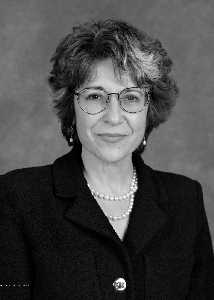
Mina Bissell Wins E.O. Lawrence Award
February 7, 1997
By Lynn Yarris, LCYarris@LBL.gov

The citation on the award will read, "For her seminal and pioneering
contributions to our understanding of the extracellular matrix and
microenvironment in differentiation, programmed cell death, and cancer."
The Lawrence Award was established in 1959 to honor the memory of the late
Ernest Orlando Lawrence, winner of the 1939 Nobel Prize in physics for his
invention of the cyclotron, and founder of the national laboratories in
Berkeley and Livermore that bear his name today. The awards are given annually
in seven categories for outstanding contributions in the field of atomic
energy, broadly defined. Winners receive a gold medal, a citation and $15,000.
Nominations were screened by independent review panels and recommended to DOE
by an interagency awards committee.
"The work of these scientists and engineers highlights the dividends that the
American people are earning on their investment in research," said acting
Energy Secretary Charles Curtis, who named the seven on Feb. 5. "The winners
have made contributions to our economy, our national security, our health and
safety, and our understanding of the universe around us. We are particularly
pleased that the independent review panels chose five of the seven winners from
the DOE family."
Bissell is a native of Iran, where she graduated as that nation's top high
school student and won a scholarship to study abroad. She chose to attend Bryn
Mawr, where she studied chemistry before transferring to Radcliffe. While a
senior at Radcliffe she won the medal of the American Institute of Chemists.
She earned her Ph.D. in microbiology and molecular genetics from Harvard
University, and came to the University of California's Berkeley campus to do
post-doctoral research in cell biology and virology. She joined the Berkeley
Lab staff in 1972 and was named director of the Cell and Molecular Biology
Division in 1988. She became director of the newly formed Life Sciences
Division in 1992.
Her training in chemistry and molecular genetics stimulated an interest in
understanding how cells develop, which led her off the beaten track of cancer
research and onto a somewhat unorthodox approach. While most cancer researchers
were searching for new types of oncogenes (cancerous genes carried by viruses),
Bissell began studying the behavior of healthy and malignant cells in culture
with an eye on the relationship between function and morphology--the changes in
structure and form that a cell undergoes as it develops. Her ultimate idea was
to define precisely what for cells is "normal."
Her research led her to postulate in 1979 that viral carcinogenesis, analogous
to chemical carcinogenesis, was a multi-step process and that the activity of a
single oncogene was not sufficient to cause cancer. In 1981, she further
proposed that the ECM was a "signalling" molecule crucial for the normal
functioning of cells. By implication then, loss or damage of the ECM could lead
to malignancy. Both ideas were considered heretical at the time but have since
been proven correct.
In the case of the ECM, conventional scientific wisdom held that it serves as
nothing more than an inert scaffold upon which cells grow and develop.
Experiments by Bissell and her collaborators, however, demonstrated that
cancerous breast cells grow at the same rate as healthy cells when placed in
standard cultures, and that both quickly take on the flat appearance of
generalized tissue cells.
If ECM is added to the culture, however, the healthy breast cells once again
become organized and begin secreting milk, while the cancerous cells once again
grow wildly into a tumorous mass.
It is now widely accepted by cancer research experts that the ECM is a dynamic
player in cell growth and development as well as in the spread of cancer and
other aberrations.
Bissell has received many honors throughout her career, including the first
Joseph Sadusk Award for Breast Cancer Research. She was elected as a AAAS
Fellow and also serves on the editorial boards of several scientific journals,
including "Cancer Research," and is currently president of the American Society
for Cell Biology.
Another local Lawrence Award winner was Charles Alcock, an astrophysicist at
Lawrence Livermore National Laboratory who is also affiliated with the Center
for Particle Astrophysics. Alcock won for his "dark matter" research into
Massive Compact Halo Objects. Other winners included Thom Dunning, a
theoretical chemist at Pacific Northwest Laboratories; Charles Jakowatz Jr., an
electrical engineer at Sandia National Laboratory; Sunil Sinha, a materials
engineer at Argonne National Lab; Theofanis Theofanous, a nuclear engineer at
UC Santa Barbara; and Jorge Valdes, a chemical engineer with Lucent
Technologies, a private firm in New Jersey.
The 1996 Lawrence Awards will be presented at a ceremony in Washington, D.C.
this spring.
Mina Bissell, director of the Lab's Life Sciences Division, has been named one
of seven winners of the 1996 E.O. Lawrence Award by the Department of Energy.
Bissell, a cell biologist, was honored in the Life Sciences category for
identifying the extracellular matrix (ECM), a network of fibrous and globular
proteins that surround and support breast cells as a crucial regulator of
normal and malignant breast cell functions.

